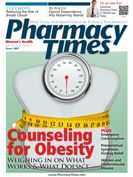Publication
Article
Pharmacy Times
Self-Care for Women's Health
Women experiencing hot flashes and vaginal dryness seek OTC treatment.
Women experiencing hot flashes and vaginal dryness seek OTC treatment.
Case 1: Hot Flashes
LG is a 53-year-old woman who is seeking your advice for relief of perimenopausal hot flashes. She experiences mild flushing sensations over her face and chest that last just a few minutes but are extremely uncomfortable. She does not have a history of breast cancer. LG reports having hypertension and thyroid disease and that she takes quinapril/hydrochlorothiazide and levothyroxine daily. She has no known medication allergies, and would like to know if there is an OTC product available to alleviate her symptoms.
Answer
Hot flashes affect between 35% and 50% of menopausal women.1 These sudden fluctuations in body heat may last between 5 and 10 minutes and may be accompanied by flushing of the face and chest and perspiration.1 These symptoms can be embarrassing and represent a common affliction for which women may be inclined to seek self-treatment.
Lifestyle modifications can help alleviate LG’s symptoms, including dressing in layers to allow for easier temperature regulation, maintaining adequate hydration, avoiding hot or spicy foods, alcohol, or caffeinated beverages, and practicing stress management and relaxation techniques. There are also a variety of herbal remedies touted to alleviate hot flashes, including black cohosh, soy isoflavones, and flaxseed.
Many OTC herbal products for menopausal symptoms contain a combination of these agents, which short-term, small-scale clinical trials have showed to have a modest effect on hot flashes. All 3 of these herbal agents seem to have weak estrogenic activity. LG should be reminded that it may take anywhere from 4 to 12 weeks for full benefit to be achieved; these agents may be used for up to 6 months as long-term safety data are unavailable. These agents should not be used by women who have a history of hormone-responsive breast cancer or those who are pregnant or lactating. Black cohosh should be avoided in patients with a history of liver disease or those taking hepatotoxic medications.
Case 2: Vaginal Dryness
VJ is a 28-year-old woman who is seeking your recommendation for the treatment of vaginal dryness. She reports that she is 12 weeks postpartum and currently breast-feeding and that her obstetrician indicated she should purchase an OTC vaginal lubricant to alleviate her vaginal dryness. VJ reports taking a prenatal vitamin and progesterone-only contraceptive pill and has no any allergies or other medical conditions. What type of product would you recommend for VJ?
Answer
Postpartum estrogen fluctuations are likely contributing to VJ’s vaginal dryness, a common complaint that can occur after delivery and while nursing due to thinning of the vaginal epithelium. This often results in atrophic vaginitis and dyspareunia, or painful intercourse. This symptom can additionally be exacerbated by exhaustion and postpartum depression, but is reversible after nursing has ceased.
In addition to recommending that VJ avoid using products that may exacerbate her condition (eg, scented panty liners, powders, perfumes, or spermicides), temporary, symptomatic relief may be achieved by using a vaginal moisturizer. Self-treatment may be recommended for women whose symptoms are mild to moderate and who do not experience any systemic symptoms or bloody vaginal discharge.2 Short-term use of OtC vaginal lubricants may alleviate symptoms of itching or irritation and may further help facilitate sexual intercourse.2 Water-soluble lubricants may be applied both internally and externally by both partners. These products contain ingredients such as glycerin, propylene glycol, or methylcellulose, and provide symptomatic relief for less than 24 hours. VJ should be counseled to reapply as frequently as needed.
For longer lasting relief, VJ could consider selecting a polycarbophil-based product, which needs to be applied just once every 3 days. Petroleum jelly should not be used, as it is difficult to remove from the vagina and can interfere with the efficacy of latex condoms and diaphragms. Topical vaginal estrogen creams may be considered after physician re-evaluation if symptomatic relief is not achieved or for persistent symptoms.
Dr. Mansukhani is a clinical pharmacist in South Plainfield, New Jersey, and clinical assistant professor, Ernest Mario School of Pharmacy, Rutgers University. Dr. Bridgeman is an internal medicine clinical pharmacist in Trenton, New Jersey, and clinical assistant professor, Ernest Mario School of Pharmacy, Rutgers University.
References
1. Perimenopause: Rocky road to menopause. Available from: http://www.health.harvard.edu/newsweek/Perimenopause_Rocky_road_to_menopause.htm. Accessed May 26, 2012.
2. Vaginal and Vulvovaginal Disorders. In: Krinsky DL, Berardi RR, Ferreri SP,et al (eds). Handbook of Nonprescription Drugs: An Interactive Approach to Self-Care, 17th edition. Washington, DC: American Pharmacists Association, 2011, pp. 128-134.
3. Prevention of Pregnancy and Sexually Transmitted Infections. In: Krinsky DL, Berardi RR, Ferreri SP,et al (eds). Handbook of Nonprescription Drugs: An Interactive Approach to Self-Care, 17th edition. Washington, DC: American Pharmacists Association, 2011, pp. 162-166.
4. Reproductive and Genital Disorders. In: Krinsky DL, Berardi RR, Ferreri SP,et al (eds). Handbook of Nonprescription Drugs: An Interactive Approach to Self-Care, 17th edition. Washington, DC: American Pharmacists Association, 2011, pp. 140-147.







